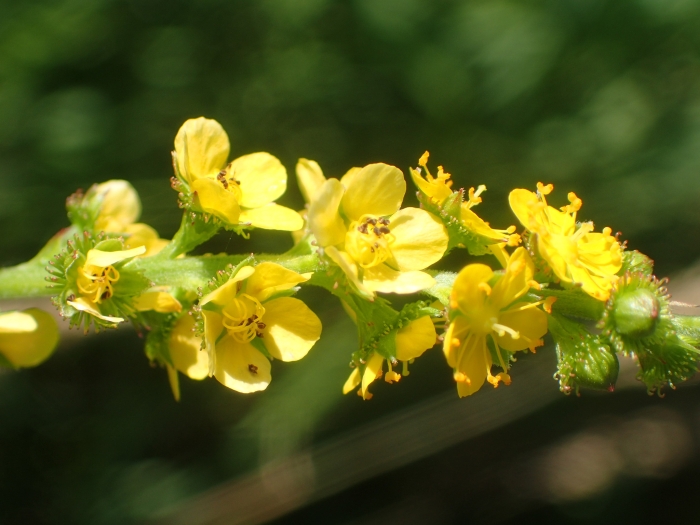Roadside Agrimony
(Agrimonia striata)
Roadside Agrimony (Agrimonia striata)
/
/

Ian Manning
CC BY 4.0
Image By:
Ian Manning
Recorded By:
Copyright:
CC BY 4.0
Copyright Notice:
Photo by: Ian Manning | License Type: CC BY 4.0 | License URL: http://creativecommons.org/licenses/by/4.0/ | Rights Holder: Ian Manning | Publisher: iNaturalist | Date Created: 2019-08-21T09:32:06-07:00 |














































Estimated Native Range
Summary
Agrimonia striata, commonly known as Roadside Agrimony, is a deciduous perennial herb native to temperate regions, including open woodlands and forest edges in the Western USA and Western Canada. It typically grows to about 40 inches (1 meter) in height and is characterized by its racemes of small, 5-parted yellow flowers that bloom in the summer. The flowers are borne on hairy stalks above the pinnately-divided leaves and are moderately showy, attracting pollinators such as bees. Roadside Agrimony is not particularly noted for its bark, berries, or fruit, but its serrated foliage can add texture to garden settings.
This plant is valued for its naturalistic appearance and ability to attract wildlife. It is often used in wildflower gardens, meadows, and naturalized areas. Roadside Agrimony is relatively easy to maintain and can be grown in a variety of soil types, provided they have good drainage. It prefers full sun but can tolerate partial shade. While it is generally a robust plant, it is susceptible to downy mildew caused by the oomycete species Peronospora agrimoniae. Gardeners should be aware of this potential issue and monitor for signs of the disease. There are no widely known cultivars of this species in the horticultural trade.CC BY-SA 4.0
This plant is valued for its naturalistic appearance and ability to attract wildlife. It is often used in wildflower gardens, meadows, and naturalized areas. Roadside Agrimony is relatively easy to maintain and can be grown in a variety of soil types, provided they have good drainage. It prefers full sun but can tolerate partial shade. While it is generally a robust plant, it is susceptible to downy mildew caused by the oomycete species Peronospora agrimoniae. Gardeners should be aware of this potential issue and monitor for signs of the disease. There are no widely known cultivars of this species in the horticultural trade.CC BY-SA 4.0
Plant Description
- Plant Type: Herb
- Height: 2-4 feet
- Width: 0.5-1 feet
- Growth Rate: Moderate
- Flower Color: Yellow
- Flowering Season: Summer
- Leaf Retention: Deciduous
Growth Requirements
- Sun: Full Sun
- Water: Medium
- Drainage: Fast, Medium
Common Uses
Bee Garden, Butterfly Garden, Edible*Disclaimer: Easyscape's listed plant edibility is for informational use. Always verify the safety and proper identification of any plant before consumption., Erosion Control, Low Maintenance
Natural Habitat
native to temperate regions, including open woodlands and forest edges in the Western USA and Western Canada
Other Names
Common Names: Woodland Groovebur, Britton’s Agrimony, Grooved Agrimony, Striate Agrimony, Woodland Agrimony, Woodland Grooveburr, Aigremoine Striée
Scientific Names: , Agrimonia striata, Agrimonia brittoniana, Agrimonia striata var. campanulata, Eupatorium brittonianum,
GBIF Accepted Name: Agrimonia striata Michx.